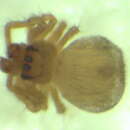en
names in breadcrumbs


The spider family Symphytognathidae includes just 68 described species (Platnick 2014), with only a single species known from North America north of Mexico (this species, Anapistula secreta, is found from the southern United States through the Greater Antilles to Colombia). The family is apparently pantropical, but is very poorly known. The first symphytognathids from China and from Europe were not discovered until 2006 and 2009, respectively (Tong and Shu-Qiang 2006; Cardoso and Scharff 2009). At least in the Nearctic, the members of this family are distinctive in possessing just four eyes and by their tiny size (body size ~0.4 mm for males and ~0.5 mm for females). Symphytognathids have fused chelicerae and, as is the case for spiders in the closely related family Anapidae, adult females lack pedipalps. Anapistula spin small (2-4 cm) flat orb webs with central radii cut out, numerous accessory radii, and very numerous sticky spirals (illustrated in Coddington 2005). Coddington (2005) briefly reviewed the taxonomic history of this family, which was first established for a newly discovered species of Tasmanian spider in 1931. Forster and Platnick (1977) published a revision including then current knowledge of the family.(Coddington 2005)Schütt (2003) undertook a phylogenetic analysis of the Symphytognathidae and closely related families.
Symphytognathidae includes the smallest known spiders (Forster and Platnick 1977; Baert and Jocqué 1993). Web-building symphytognathids are believed to live in leaf litter, hollow logs, and other small, extremely humid microhabitats, although under the right conditions they will spin webs at least a meter or two above the forest floor. The spiders seem to spend most of their time at the web hub, but if disturbed they move slowly to the periphery. At least some Curimagua are apparently commensals in the webs of much larger spiders (Vollrath 1978). According to Coddington (2005), although most new symphytognathid species have been found by litter extraction methods, the webs can be detected by wafting clouds of cornstarch across likely patches of leaf litter, low-growing vegetation, or moss.
As with related families (Theridiosomatidae, Anapidae, Mysmenidae), web construction is believed to include out-of-plane radii, but these radii are cut during construction, resulting in a flat web. Completed webs appear to have hundreds of radii, but most of these are actually "accessory" radii added to the underside of the web after sticky spiral construction. True and accessory radii can be distinguished because the path of a sticky spiral bends sharply at true radii but continues straight across accessory radii. After accessory radius construction, the hub area is rebuilt to reduce the number of radial lines reaching the hub. (Eberhard 1986; Coddington 2005). Egg sacs are guarded at the margin of the web (Griswold and Yan 2003). Based on the small size of these spiders, their fine-meshed webs, and their fused chelicerae, Fritz Vollrath has speculated that symphytognathids may be vegetarians, using their webs to capture pollen and spores from the air (pers. comm. cited in Coddington 2005). This would be noteworthy if true since spiders are thought to be generally strictly carnivorous (although at least one Neotropical jumping spider [Salticidae] is apparently largely, or even mainly, vegetarian, feeding on the Beltian food bodies of Vachellia "ant-acacias"; Meehan et al. 2009).
Symphytognathidae is a family of spiders with 90[1] described species in eight genera. They occur in the tropics of Central and South America and the Australian region (with Oceania). Exceptions include Anapistula benoiti, Anapistula caecula, and Symphytognatha imbulunga, found in Africa, Anapistula ishikawai, found in Japan, and Anapistula jerai, found in Southeast Asia.[2]
The species Patu digua is considered to be one of the smallest spiders in the world with a body size of 0.37 millimetres (0.015 in).[3]
Symphytognathidae are four-eyed spiders and are generally small in size. The opisthosoma is covered in long hairs.[4]
As of April 2019, the World Spider Catalog accepts the following genera:[2]
Symphytognathidae is a family of spiders with 90 described species in eight genera. They occur in the tropics of Central and South America and the Australian region (with Oceania). Exceptions include Anapistula benoiti, Anapistula caecula, and Symphytognatha imbulunga, found in Africa, Anapistula ishikawai, found in Japan, and Anapistula jerai, found in Southeast Asia.
The species Patu digua is considered to be one of the smallest spiders in the world with a body size of 0.37 millimetres (0.015 in).